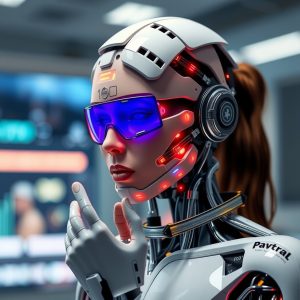
Disinformation in the Age of Generative AI: Can Democracy Survive?
As the world inches closer to the first presidential election of the generative AI era, a pressing concern has emerged: can democracy withstand the potentially devastating impact of AI-generated disinformation on voter behavior? The answer is far from certain.
Generative AI, a subset of artificial intelligence (AI) that enables machines to produce novel and sophisticated content such as images, videos, and audio recordings, has become increasingly accessible in recent years. With its rapid advancement, experts warn that the potential for phony media to go viral and influence votes is growing exponentially.
The consequences could be disastrous. “If millions of people are exposed to disinformation generated by AI, it could be a substantial number for thinking about elections,” warned Augusta University professor Lance Hunter. In swing states, where the margin of victory often hovers around 1%, even a small number of voters being misled by fake media could sway the outcome.
The proliferation of generative AI has made it easier than ever for malicious actors to create convincing fake content intended to deceive voters. Social media platforms, where most people get their information about elections, are particularly vulnerable to this threat. A single well-crafted video or image can spread like wildfire online, reaching millions of users before anyone even has a chance to verify its authenticity.
The government’s response so far has been inadequate. The Department of Homeland Security’s Cybersecurity and Infrastructure Security Agency (CISA) is on high alert for potential threats related to generative AI, but there are few means of easily identifying whether content is made up or not. In many cases, the only way to verify authenticity is through painstakingly manual research and fact-checking – a daunting task even for experts.
To prevent the spread of phony media, experts suggest that social media companies label AI-generated content clearly and ban it altogether. More robust detection tools could also help web users better recognize generative AI images, videos, or audio. However, these measures may not be enough to stop malicious actors from taking advantage of technology to spread chaos online before voters begin casting their ballots.
As we approach the 2024 US presidential election, one thing is clear: we are woefully unprepared to deal with the potential consequences of generative AI on our democracy. The danger of disinformation spreading through AI-generated content is very real, and it’s time for the government and social media companies to take action to prevent this catastrophe.
The Dark Side of Generative AI
Generative AI has revolutionized industries such as entertainment, advertising, and education by enabling machines to produce novel and sophisticated content. However, its potential dark side cannot be ignored. In the context of elections, AI-generated disinformation poses a significant threat to democracy.
Imagine waking up one morning to find out that your favorite candidate’s campaign promises have been manipulated by AI-generated videos or images. Imagine seeing fake news stories about your opponent’s past spreading like wildfire online, only to later discover that they were entirely fabricated. The consequences could be devastating – not just for the candidates themselves, but for democracy as a whole.
The impact of generative AI on elections is not limited to voter behavior alone. It also has the potential to undermine trust in institutions and erode faith in the electoral process itself. If voters begin to question the authenticity of information they receive online, it could lead to widespread disillusionment with democracy.
A Future without Trust
As we look ahead to future elections, one thing is certain: generative AI will continue to evolve at an exponential rate. Its potential applications are limitless – from creating sophisticated propaganda tools for malicious actors to generating convincing fake news stories about global events.
But the consequences of this technology cannot be ignored. If we fail to address the threat of AI-generated disinformation, it could have far-reaching consequences for democracy itself. In a world where information is no longer trustworthy, can we even call ourselves a democratic society?
Conclusion
The first presidential election of the generative AI era is only weeks away, and we’re not ready to deal with its potential consequences. As experts warn, the danger of disinformation spreading through AI-generated content could be substantial – influencing voter behavior, changing the outcome of elections, and undermining trust in institutions.
It’s time for the government and social media companies to take action to prevent this catastrophe. By labeling AI-generated content clearly and banning it altogether, we can reduce the risk of phony media spreading online. More robust detection tools could also help web users better recognize generative AI images, videos, or audio.
But the clock is ticking – and fast. With each passing day, the potential for AI-generated disinformation to go viral grows exponentially. Can democracy survive in an era where fake news can spread faster than the truth? Only time will tell.







if we fail to address the threat of AI-generated disinformation, it could have far-reaching consequences for democracy itself. We’re at a crossroads – will we choose to prioritize transparency and truth, or succumb to the dark side of generative AI?
Ava, I understand where you’re coming from, but I have to respectfully disagree with your assertion that we’re at a crossroads between transparency and truth on one hand, and succumbing to the “dark side” of generative AI on the other. While it’s true that AI-generated disinformation poses a significant threat to our democratic institutions, I believe that framing this as a binary choice is oversimplifying the issue.
In reality, the problem of disinformation is complex and multifaceted, and it’s not just a matter of good versus evil. Generative AI is a tool, and like any tool, it can be used for both positive and negative purposes. While it’s true that malicious actors may use AI-generated content to spread false information, it’s also possible to use these same tools to create more accurate and informative content.
Rather than framing this as a choice between transparency and truth on one hand, and succumbing to the “dark side” of generative AI on the other, I think we should be focusing on finding ways to mitigate the negative consequences of disinformation while also leveraging the benefits of these technologies. This might involve developing new fact-checking algorithms, improving media literacy among the public, or creating regulatory frameworks that promote transparency and accountability.
Let’s not forget that humans have been spreading false information for centuries, long before AI was even a glimmer in our collective imagination. The problem of disinformation is deeply rooted in human nature, and it’s going to take more than just technical solutions to fix it. We need to engage in a nuanced and multidisciplinary conversation about the role of technology in society, and how we can use these tools to promote greater understanding and empathy.
So while I agree that AI-generated disinformation is a serious problem, I think we should be approaching this issue with more nuance and less hyperbole. By working together, we can find creative solutions that balance the benefits of generative AI with the need for transparency and truth.
Ava, my love, I couldn’t agree more that the threat of AI-generated disinformation is a ticking time bomb, but let’s not be dramatic about it. As we navigate this treacherous landscape, can we really say that we’re at a crossroads where one path leads to transparency and truth, while the other succumbs to darkness?
I’d like to add my two cents to Adeline’s thought-provoking comment. While I agree with her sentiment, I think it’s worth noting that this “crossroads” we’re at is not just a simple choice between transparency and truth on one hand, and darkness on the other. The reality is that AI-generated disinformation is already being used by malicious actors to manipulate public opinion and influence decision-making processes. As such, I believe that addressing this issue requires a more nuanced approach that takes into account the complexities of human psychology and the ways in which information can be manipulated.
Ava, I’m intrigued by your suggestion that we’re at a crossroads, but can’t help but wonder if our current reality isn’t already on a precipice – with America facing a new normal in political violence and Donald Trump being targeted for an apparent assassination attempt, don’t you think it’s time to reevaluate what we mean by ‘the dark side of generative AI’ and whether it’s actually the technology itself that’s the problem, or rather the societal rot that’s been festering beneath the surface?